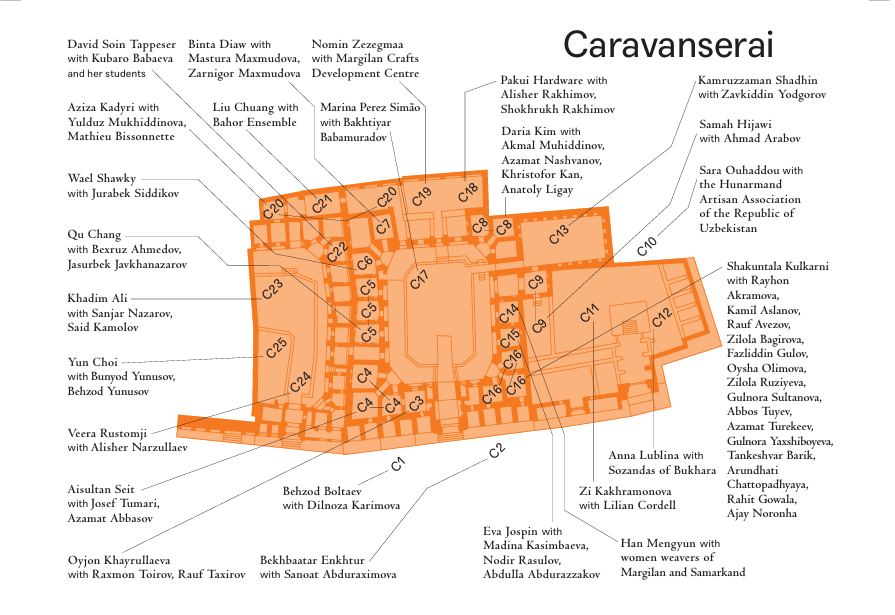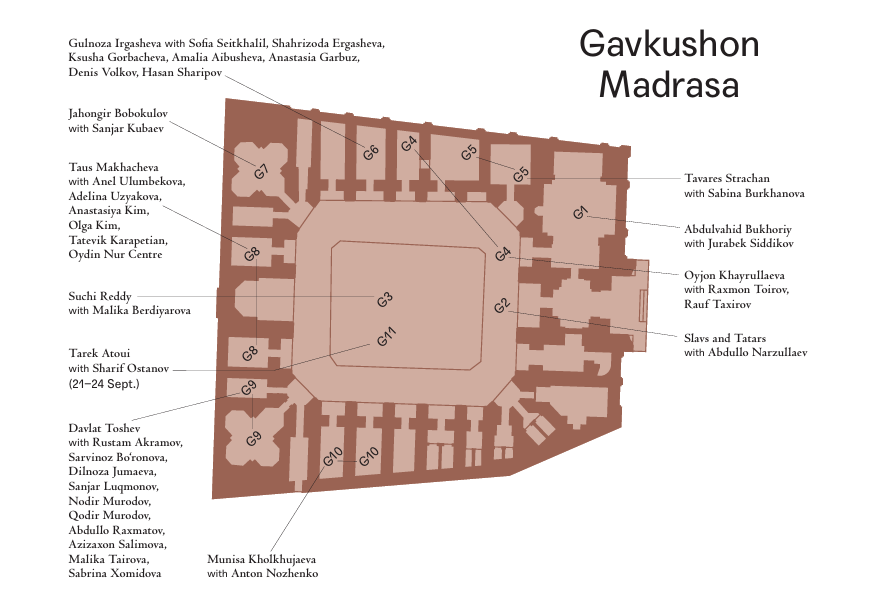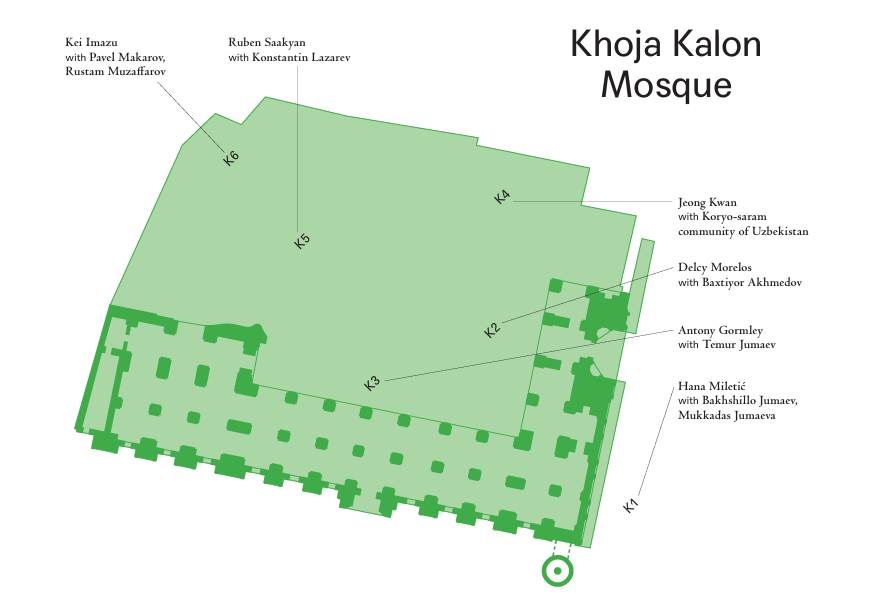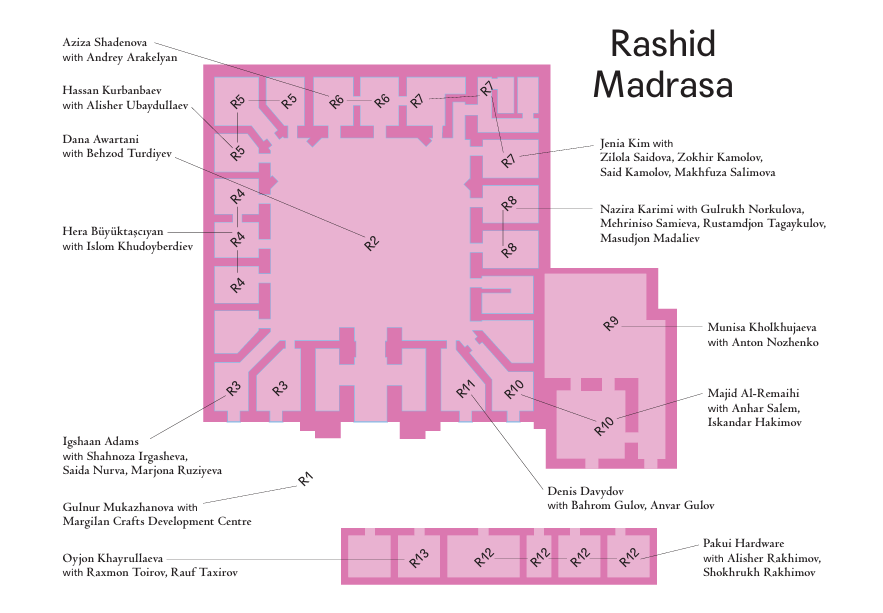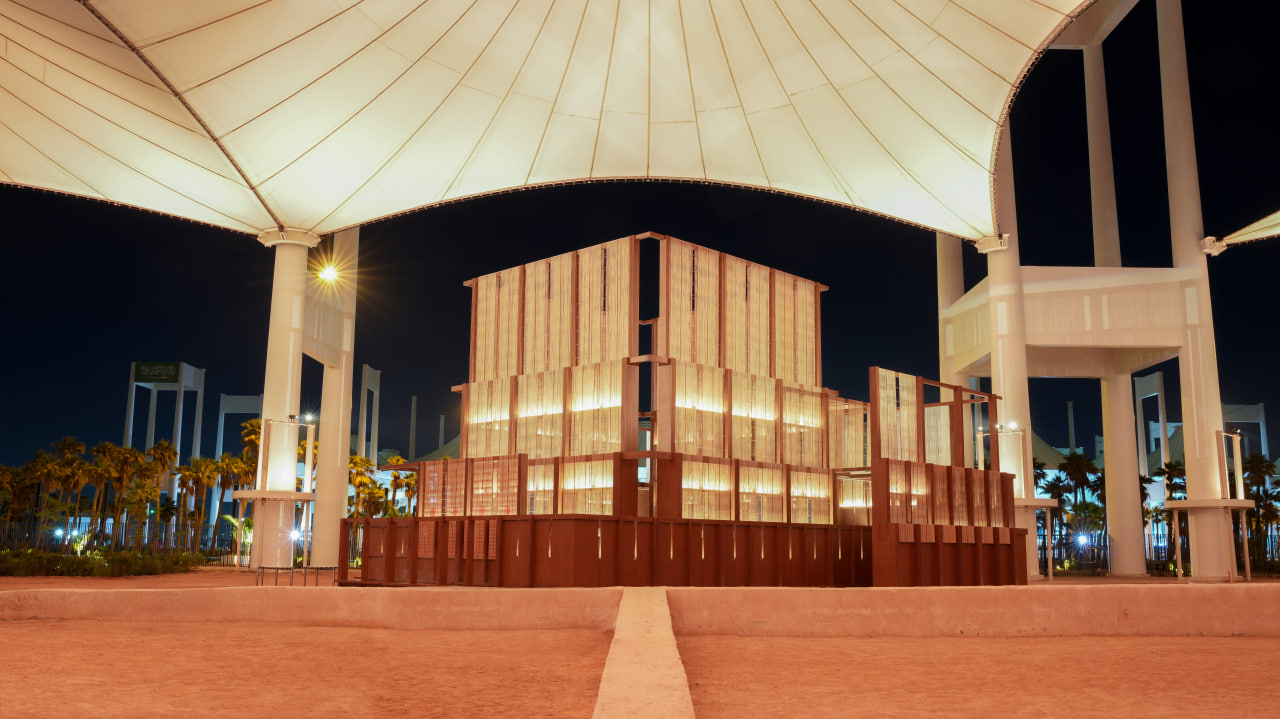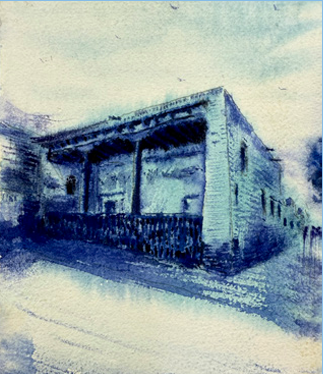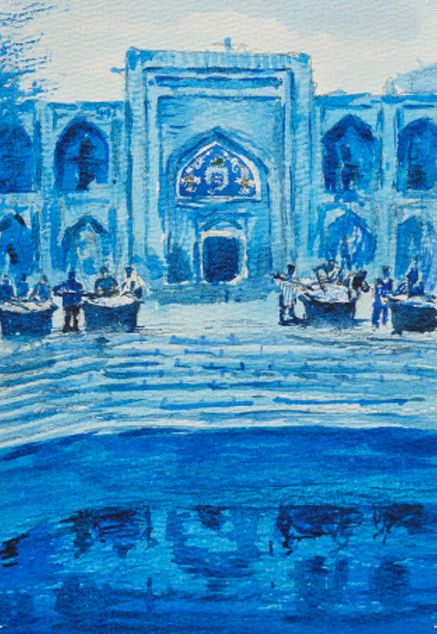Tickets
The admission is free.
No commercial photography or filming is permitted on the premises of the Bukhara Biennial without prior written authorisation from the Biennial’s management. Any material produced without such consent will be subject to legal action.
Directions
Arrival by Plane
Bukhara can be reached by landing directly at Bukhara International Airport (BHK), located about 6 km from the city center.
📍 Address: Airport Highway, Kogon District, Bukhara Region
Direct flights are available from Tashkent, Moscow, Istanbul, and other Central Asian cities.
Alternatively, you can take a domestic flight from Tashkent International Airport (TAS).
Flight time: approximately 1 hour.
Regular flights operate on select days (e.g. Wednesdays and Saturdays), typically departing around 07:00 and arriving in Bukhara at 08:10.
In addition, Silk Avia regional airline operates daily flights between Tashkent and Bukhara, offering greater flexibility for travelers.
From the airport: Taxis and Yandex app take around 15 minutes to reach the Biennial venue.
You can book direct flights from Tashkent to Bukhara via Uzbekistan Airways on their official website uzairways.com.
Arrival by Rail
From Tashkent, high-speed and regional trains (Afrosiyob and Sharq) run daily to Bukhara.
Travel time: approx. 3.5 to 6 hours depending on the train type
Departure station: Tashkent Central Railway Station (Tashkent-1)
📍 Address: 7 Turkistan street, Mirabad district, Tashkent, 100060
Arrival station: Bukhara-1 (Kogon) Railway Station
📍 Address: Kagan City, Bukhara Region
Shuttle buses and taxis are available at the arrival station.
From the station: Taxi rides to the Biennial venue take approximately 15–20 minutes.
Current rail connections and travel times are posted at the website of the Uzbekistan Railway: railway.uz
Public Transport
Long-distance buses connect Tashkent and Bukhara regularly.
Travel time: approx. 8 to 10 hours
Departure terminal: Tashkent Bus Station (Avtovokzal)
📍 Address: 7 Bunyodkor Avenue, Chilanzar District, Tashkent
Arrival terminal: Bukhara Central Bus Terminal
📍 Address: Gijduvon Road, Bukhara City
From the bus terminal: Taxi rides to the Biennial venue take about 10 minutes.
Bus tickets between Tashkent and Bukhara can be booked in advance on avtoticket.uz, Uzbekistan’s official intercity bus ticketing platform.
Information
Exhibition Venues & Schedule
Period 05.09.–23.11.2025
The project sites are open from Tuesdays to Sunday: 10am to 10pm (September) / 10am to 8pm (October and November). Artworks displayed in the streets are available at all time.
Visitor Advisory:
Please note that during periods of unfavourable weather, access to some exhibits may be temporarily restricted to ensure both visitor safety and the protection of our artworks. We appreciate your understanding and encourage you to check conditions in advance.
Public Spaces
The Cultural District of the biennial contains many layers of history that build up contemporary life in the Old City of Bukhara. The biennial begins at Toqi Sarrafon, one of the several ‘trading domes’, a sixteenth-century typology of covered bazaars; this one served as a hub for money exchange, run by Indian and Jewish merchants. The entire biennial area follows the path of the ancient Shakhrud Canal, which once brought water to the city from the Zarafshon River through a sophisticated system of hauz pools. Few of them remain in use, and a magnificent one is located in front of the Khoja Gavkushon complex, the best-preserved example of a sixteenth-century public space of this kind in Central Asia.
This square serves as the epicentre of the biennial’s public life and a vibrant gathering point. Recipes for Broken Hearts features over 70 projects spread across 500 metres of public space and ten weeks of time, linking all of the exhibition sites with works that invite connection between visitors and Bukharian neighbours who live and make art here; the route winds through mahalla neighbourhoods that are home to many artisans, especially embroiderers and gold embroiderers. These pieces create space to feel, to find solace, to rest, to hope, and to dream. They were made under the same environmental conditions in which they’re now shown – woven into the rhythms of daily life in Bukhara, not set apart from it. Most forms of heart break are not romantic – and they often involve far more than two people. This biennial is not about broken hearts; it’s about the recipes to mend them. Cures, like recipes, are not static. Inspired by the wonder we knew as children that can spark the wildest sense of imagination, we might invent new recipes to heal one another. This is not an exhibition meant to be experienced alone, but one that celebrates what is possible when we show up for each other.
Caravanserai
Four interconnected caravanserais – Fathullajon, Ayozjon, Ahmadjon, and Mirzo Ulugbek Tamakifurush – date to the eighteenth and nineteenth centuries and together formed a complex that served both as accommodation for travelling merchants and as a centre of commerce, specialising in the sale of dishware and locally produced tobacco. Their typology features a central courtyard surrounded by small rooms known as hujras, along with niches for feeding donkeys and a stable for horses.
Reflecting their original function, the caravanserais were repurposed as housing in the twentieth century before falling into disrepair and eventual abandonment. In the early 2000s, two – Fathullajon and Ayozjon – were restored, while Ahmadjon and Mirzo Ulugbek Tamakifurush remain in ruins. At the centre of the latter, a visible pit marks the former basement once used for storing goods.
We enter the caravanserais through the motif of the heart and navigate the interconnecting hujras to understand that heartbreak is a stop, or multiple stops, on the journey of life. Heartbreak warps our sense of distance and our connection to time and space. This site presents the widest geographical spread of artists – from Afghanistan to Australia, from Brazil to Bangladesh, from Senegal to South Korea – speaking to Bukhara’s importance as a centre of exchange for centuries.
It addresses the myth of Ibn Sina and proposes how we can heal the artisan, in addition to the prince. Bukhara, like many societies, has risen from the ruins of many chapters of heartbreak. It offers recipes for peace, suggesting that we can live together with difference by creating together. In the words of sociologist Gargi Bhattacharyya, ‘What if heartbreak is not something to overcome, but something we move forward with?’
Gavkushon Madrasa
The Gavkushon Madrasa was built in 1570, featuring a traditional courtyard layout adapted to an unusually shaped, trapezoidal plot at a street fork. Endowed by the influential Sheikh Khoja Said – known as Khoja Kalon – the madrasa forms part of a larger complex named in his honour.
The name ‘Gavkushon’ means ‘bull slaughter’, suggesting that the site was formerly used as a cattle market or slaughterhouse. With over 30 rooms, a library, and a large prayer hall that also served as a lecture space, the madrasa remained a centre of learning for centuries before being repurposed for housing and a craft school in the twentieth century.
The exhibition brings tenderness to this historically charged space, where four majestic mulberry trees anchor an environment designed for learning from our feelings as opposed to feeling from our learnings. It transforms into the House of Softness – a sanctuary that teaches us to face hardship without hardening our hearts. Drawing inspiration from Baghdad’s House of Wisdom, it hosts interdisciplinary conversations and creative collaborations from across the globe.
Part library, part tea house, part poetry workshop, part artisan studio, part classroom, part exhibition space – the House of Softness challenges the tired hierarchy of teacher-on-stage and students-in-rows, fostering instead a space where knowledge flows freely between all who gather. A collaboration with the Nationwide Children’s Library expands the reach of the multigenerational journey of lifelong learning we seek to inspire in this space. In the words of Persian poet Shams Tabrisi, ‘You will learn by reading, but you will understand with love.’
Khoja Kalon Mosque
Built in 1598, the Khoja Kalon Mosque was the second- largest mosque in Bukhara, after the nearby Poi-Kalon complex, which inspired its design. Part of the Khoja Gavkushon Ensemble, it was commissioned by Sheikh Khoja Said – known as Khoja Kalon (‘the great Khoja’) – a prominent leader of the Naqshbandi Sufi order and an influential political figure who also oversaw Bukhara’s water system.
The mosque featured a spacious rectangular courtyard surrounded by domed galleries and a large domed prayer hall. Most of the structure collapsed in the twentieth century and was repurposed as a warehouse; only the minaret survived. The front portal was restored in the 1990s, but much of the building remains in ruins. Healing was once considered an art; today it is considered a science. While nothing new to the kind of Sufism practised in Bukhara, science today suggests that awe, defined by psychologist Dacher Keltner as the feeling of being in the presence of something vast that transcends your current understanding of the world, is critical to our sense of well-being. Art, as well as illness and healing, alters our perception.
The site and artworks in Khoja Kalon seek to create a space where we perceive that we can spiritually transcend the hardness and limitations of the physical world we inhabit today. All of the projects in this site connect us to the life-giving power of the earth, which holds us from womb to tomb. Placed in a site that is currently undergoing restoration, this chapter of Recipes for Broken Hearts inspires us to look at the interconnected relationship between how we transform our world inside in order to transform the world outside for ourselves and also for future generations.
Rashid Madrasa
The Rashid Madrasa is the last venue of the biennial, situated in a picturesque area of Bukhara’s Old City, near the Shahrud Canal. Many of the artisans live in the nearby lanes, this area was once known as a neighbourhood of embroiderers. Built in the eighteenth-nineteenth century by the affluent Afghan tea merchant Abdurashid (Rashid), the madrasa featured classrooms, a prayer room, and living quarters for students.
In the twentieth century, it was closed and repurposed as housing and later as a camera and home appliances repair shop. Healing is a process of repair that requires labour – we must work through things to resolve them and step into what comes next. Heartbreak is too vast for any single remedy; it demands an entire toolkit.
The Rashid Madrasa presents artworks that offer the instruments we need: ways to process, mourn, memorialise, and ultimately move beyond broken-heartedness. Some tools are expressive – humour that lets us release what we’ve been holding, laughter that creates space to breathe. Others are social, weaving us back into connection and belonging with ourselves and with each other. And some are symbolic, like mourning rituals that give form to the formless, making what felt impossible to grasp suddenly comprehensible.
AlMusalla in Bukhara
Launched by the Diriyah Biennale Foundation, the AlMusalla Prize is an international architecture competition for the design of a Musalla, a space for prayer and contemplation, inaugurated on the site of the Islamic Arts Biennale – the Western Hajj Terminal at King Abdulaziz International Airport in Jeddah, Saudi Arabia, in January 2025.
The winning team for its inaugural edition is composed of a collective from EAST Architecture Studio, based in Lebanon and the UAE; the international engineering firm AKT II, based in the UK; and Beirut- and San Francisco-based artist Rayyane Tabet. They were selected from a shortlist of architects, including AAU Anastas (Palestine), Sahel AlHiyari (Jordan), Dabbagh Architects (Saudi Arabia), and Asif Khan (United Kingdom). Jury members for the competition are Prince Nawaf Bin Ayyaf (jury chair), Farrokh Derakhshani, Lina Ghotmeh, Azra Akšamija, and Ali Malkawi. The inauguration of the Musalla coincided with the opening of the second edition of the Islamic Arts Biennale on 25 January 2025.
The competition brief asked architects to form teams that included an artist and an engineer to collaboratively design a Musalla that is a versatile, modular space for prayer, welcoming both Muslim and non-Muslim visitors. The brief specified that the structure should meet all the requirements for prayer, be at least 150 square metres in size, and be sustainable in its method of construction. It also stressed the importance of the structure being easily disassembled and reassembled, emphasising the afterlife and legacy component of the project – for the structure to live beyond the duration of the Islamic Arts Biennale.
The Diriyah Biennale Foundation is delighted to present its first edition of AlMusalla, inaugurated at the Islamic Arts Biennale in Jeddah, Saudi Arabia, in January 2025, and now on display in the historic centre of Bukhara, thanks to the generous support of ACWA Power and Vision Trust.
Library Pop-Up
The Nationwide Children’s Library has opened a pop-up reading space in a former mosque located in a historic neighbourhood adjacent to the biennial sites. Built in the nineteenth century, the Pochakul Khoja Mosque once served as a local place of worship for an artisan community. Now, it offers a space for reading centred on children’s literature – welcoming readers of all ages.
Café Oshqozon
Café Oshqozon gets its name from the Uzbek word for ‘stomach’ or ‘a vessel for cooking’, imagining the biennial as a living body nourished by shared meals. Inspired by Ibn Sina’s recipes for physical and emotional healing, international and Uzbek chefs create new recipes for mending broken hearts, developing new menus that are accompanied by storytelling. Guests are invited to share dishes reflecting Bukhara’s history as a hub of the global spice trade, alongside lectures, workshops, and conversations.
Rooted in Uzbekistan’s deep culture of hospitality—where food is a mainstream language of care—this curatorially developed restaurant treats cooking and eating as more than a source of pleasure and more than a source of nourishment. It becomes a way to connect, reflect, and heal. The link between eating and restoration is centuries old. The word “restaurant” comes from the French restaurer, meaning ‘to restore,’ first used in eighteenth-century Paris for places serving broths to regain strength. The poet Rumi used cooking as a metaphor for spiritual growth, describing the soul as a chickpea softened by the fire of love and longing. At Café Oshqozon, food becomes a medium for tracing the ties between care, culture, and transformation—reminding us that even the most familiar ingredients often carry long histories of migration, and that through shared meals, we bring the world a little closer together.


